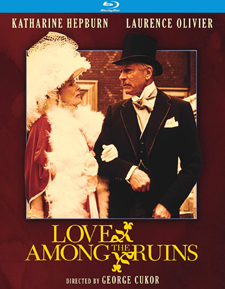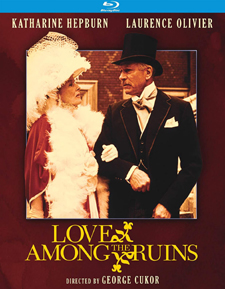Love Among the Ruins (Blu-ray Review)

Director
George CukorRelease Date(s)
1975 (April 21, 2020)Studio(s)
ABC Circle Films (Kino Lorber Studio Classics)- Film/Program Grade: A-
- Video Grade: B
- Audio Grade: B
- Extras Grade: B-
Review
A comedy-drama made for television in 1975, Love Among the Ruins is the only film to co-star Katharine Hepburn and Laurence Olivier. Both actors were big stars during the Golden Age of Hollywood. Hepburn had recently won her third Oscar for The Lion in Winter and Olivier had just competed ten years at England’s National Theatre.
Olivier plays the never-married barrister Sir Arthur Glanville-Jones, hired to defend Hepburn’s character, wealthy widow and former actress Jessica Medlicott, against a breach-of-promise lawsuit brought by young opportunist Alfred Pratt (Leigh Lawson) claiming that she had agreed to marry him. Such lawsuits were not uncommon in the early twentieth century, but were usually brought by women against men.
Sir Arthur is excited to see Jessica because 40 years earlier, when she was in a touring company playing in Canada, they spent three days and nights together before she moved on with the company. He’s surprised and saddened that she doesn’t seem to recognize him but continues to hope she will recall their affair as they prepare their arguments. The case doesn’t bode well for her. Headstrong, independent, and even imperious, she isn’t always amenable to legal advice and the friction often causes sparks between lawyer and client.
Directed by veteran George Cukor (The Philadelphia Story, My Fair Lady), Love Among the Ruins is a sentimental comedy with two outstanding performances. Hepburn has a field day with the flamboyant Jessica, a woman who knows her mind and is unafraid to express exactly what she thinks. Olivier has the more subtle role of a man still carrying a place in his heart for his long-ago lover. The chemistry between them is formidable. Hepburn cut her teeth on screwball comedy in the 1930s, but Olivier is associated more with moody dramatic roles, so it’s a delight to see him handling writer James Costigan’s dialogue deftly and with perfect timing.
A comedy of manners with period elegance, the film is set mostly in offices or in the courtroom with a few exterior scenes to open it up a bit. An early scene, for example, shows Sir Arthur running in a downpour, without an umbrella, to his offices. Other outdoor scenes feature Jessica arriving or leaving Sir Arthur’s office in a period Rolls-Royce. Director Cukor has staged the scenes—many quite lengthy— with subtle camera movements and blocking so that the eye is constantly seeing new compositions. The dialogue is so well written and the stars and supporting actors so uniformly high caliber that the limited settings are not a distraction.
Jessica is a role that suits Hepburn. She gets to wear sumptuous costumes, deliver intelligent, witty dialogue, and dominate the story. The best moment of the film, however, belongs to Olivier. It is Sir Arthur’s summation, when he has to convince the jury that Jessica was the victim, not the predator. As the camera stays with him throughout the long monologue, we see why this actor was considered the greatest of his generation. With his careful pauses, facial expressions, and thoughtful presentation, his delivery is mesmerizing.
The production was shot in London in six weeks with a predominantly British cast for ABC Theatre Films, a series that began in 1969 as ABC’s Movie of the Week. Those 90-minute films turned out to be so popular and profitable that the network expanded their film production into ABC Theatre Films, two-hour movies with a more substantial budget. Because of this, Love Among the Ruins has a rich, theatrical look with classy credits and pretty location footage.
There are a few places where the narrative sags and the forward thrust of the story is slowed. A bit of streamlining and judicious editing would have made the pace crisper. Overall, however, Love Among the Ruins is a tour de force for two legendary screen actors.
The dual-layered BD-50 Disc, newly restored from a 2K master by Kino Lorber Studio Classics, features 1080p resolution and is presented in the aspect ratio of 1.66:1. The early twentieth century period is captured through meticulous production and opulent costume design. The color palette is subdued. The office of Sir Arthur and the courtroom feature browns and blacks. Hepburn wears deep brown when she first appears and later wears a pale sage-green dress. It’s only in her final appearance in court that she illuminates the dull surroundings with her bright red dress and large white ostrich plume hat. Apart form Jessica, only Pratt’s mother wears a brightly colored dress. Another splash of color is Jessica’s yellow Rolls-Royce. An early scene, bluish in hue, shows Sir Arthur running in a downpour to his office. The film is notable for its long, uninterrupted scenes. The camera and the actors are constantly moving to avoid a static look. Cukor was known for this approach, avoiding the piecing together of a scene with numerous angles.
The soundtrack is English mono DTS-High Definition Master Audio. Optional English subtitles are available for the hearing impaired. Dialogue is precise, as would be expected from two veteran actors who worked for years on the stage and in the movies. The British supporting cast also deliver their lines distinctly and with appropriate feeling. Because dialogue dominates, there is little ambient background sound with the exception of rainfall, some street noise in the outdoor sequences, and laughter and gasps in the courtroom scenes. Olivier’s monologue is a tour de force of acting. His Sir Arthur recounts what the jury has witnessed in court and provides a sympathetic portrait of Jessica as a victim to be pitied. During his summation, we see intermittent flashbacks as he thinks back to his weekend with Jessica forty years ago, a bittersweet, faraway look in his eyes.
Bonus materials on the Unrated Region A Blu-ray release include an audio commentary and five trailers.
Audio Commentary – Film historian Stephen Vagg notes that Katharine Hepburn and George Cukor had worked together frequently but Love Among the Ruins was the first actor-director pairing of Olivier and Cukor. Shortly after making this film, Olivier would come down with a muscular disease that would plague him for the rest of his life. James Costigan wrote the story in the 1960s as a TV vehicle for legendary stage performers Alfred Lunt and Lynn Fontanne, to be shot in a TV studio with very few sets, but the Lunts eventually backed out. George Cukor enjoyed long takes. “He let scenes breathe.” He knew that Hepburn and Olivier could do long, sustained scenes, which he felt were “more real, more truthful, less acted.” Cukor didn’t look through the camera; he focused his attention on the actors. He wanted the characters to shine. Hepburn was attracted to the role of a “vain and imperious” former actress because the film was much lighter than the ones she had been doing. She commented, “I thought it would be fun to do something silly rather than pompous.” She was disillusioned by the movies being made in the 1970s. Overviews of the careers of Hepburn and Olivier are provided, as well as background on the supporting cast members, many of whom had distinguished careers in the British theater. Hepburn suggested Oliver for the role of Sir Arthur, but he wasn’t interested at first and there was a conflict about billing. It was agreed that in America, Hepburn’s name would be first, and in England, Olivier’s name would head the cast. ABC financed the film and IBM agreed to sponsor it with only one commercial break. The film is based on actual breach of promise lawsuits. In literature, these actions were often used for comedy. Shakespeare, Dickens, Gilbert & Sullivan, and Mae West are among those who used this as a plot point. Love Among the Ruins was never released theatrically because of a clause in Olivier’s contract, but it did play at several film festivals. The popularity of courtroom dramas on screen is mentioned. Subsequent to Love Among the Ruins, writer Costigan was hired by Alfred Hitchcock to write the screenplay for a film (never made) called The Short Night. Hitchcock found Costigan to be “uncinematic and obstinate.” Many actors expressed admiration for Love Among the Ruins, including Loretta Young, James Cagney, Christopher Walken, and Patrick Duffy. Vagg believes that the film would have been better if Jessie had remembered Sir Arthur earlier. The film’s title comes from an 1855 poem by Robert Browning, which has been used as the title of a play by Elmer Rice, an episode of the TV series Mad Men, and an album by the rock band 10,000 Maniacs. Vagg reads the entire Browning poem, concluding several minutes before the film is over.
Trailers – Five trailers are included: The Lion in Winter, A Delicate Balance, and Grace Quigley (starring Katharine Hepburn), and The Devil’s Disciple and Three Sisters (starring Laurence Olivier).
– Dennis Seuling

